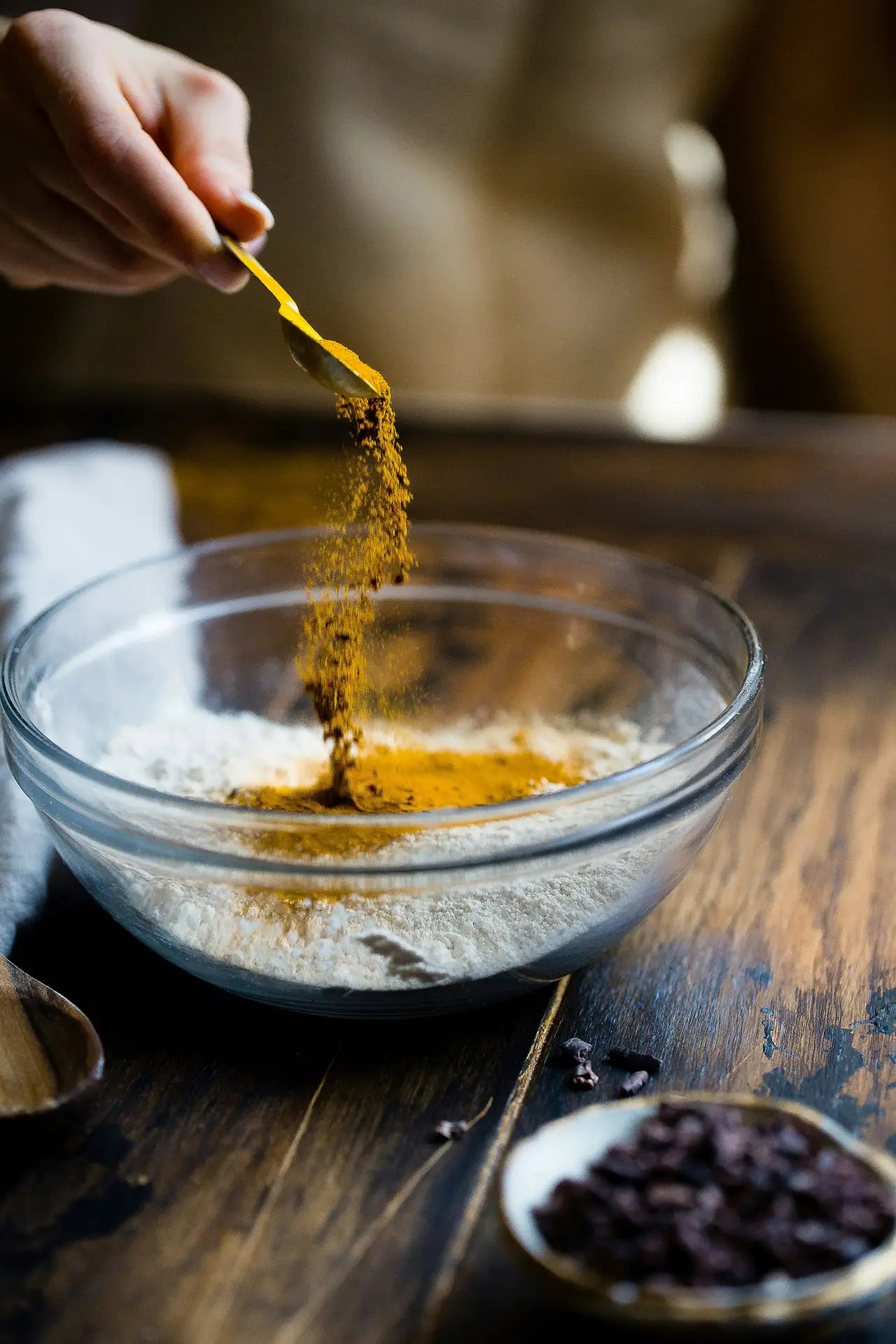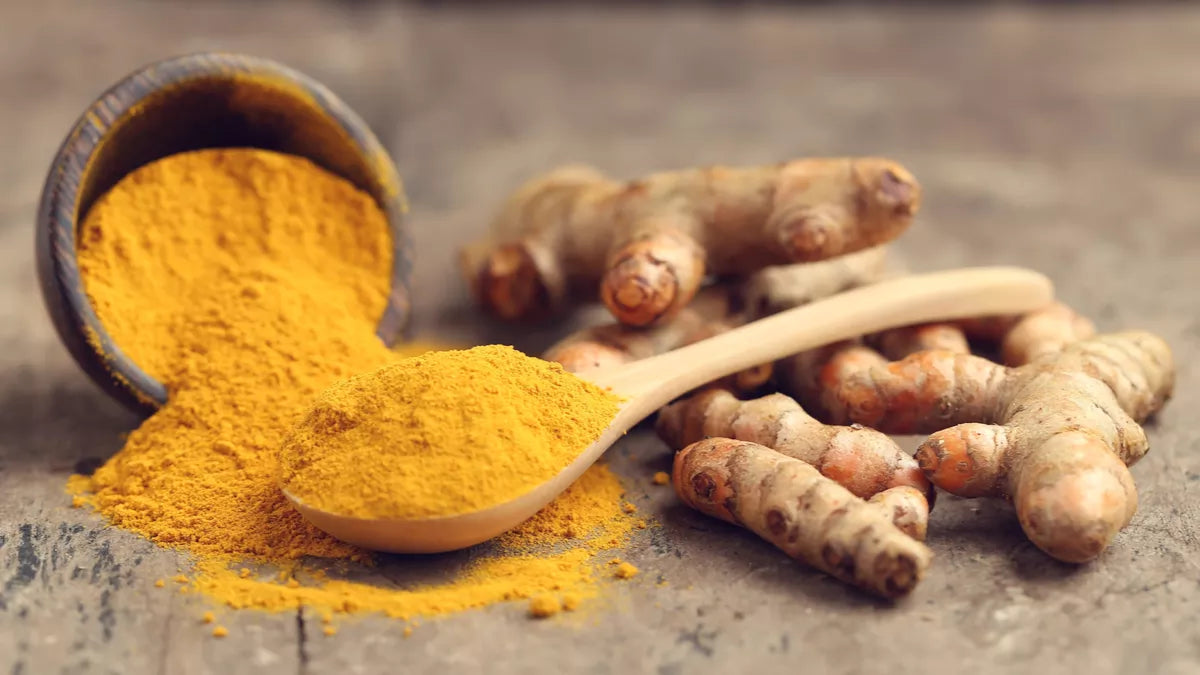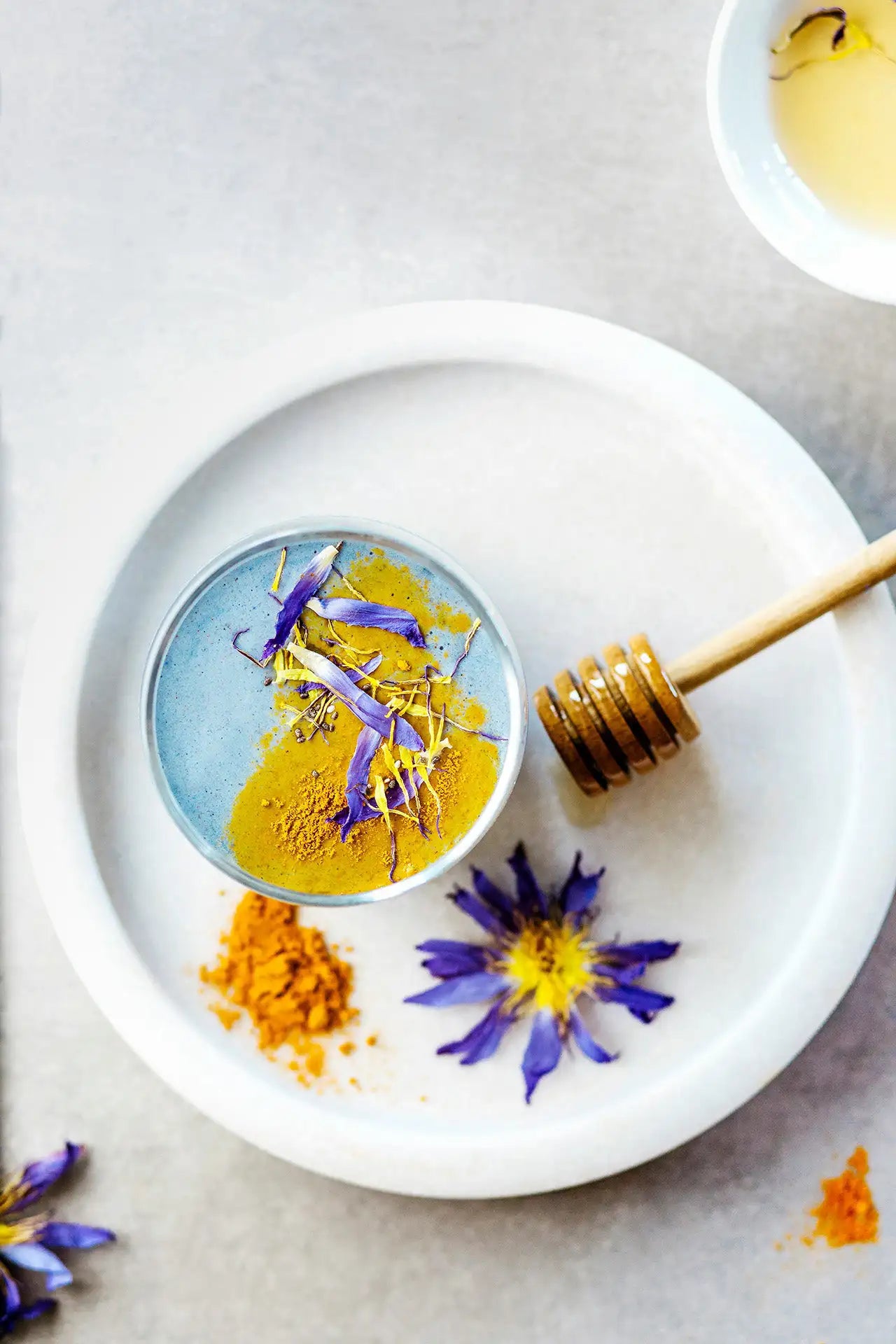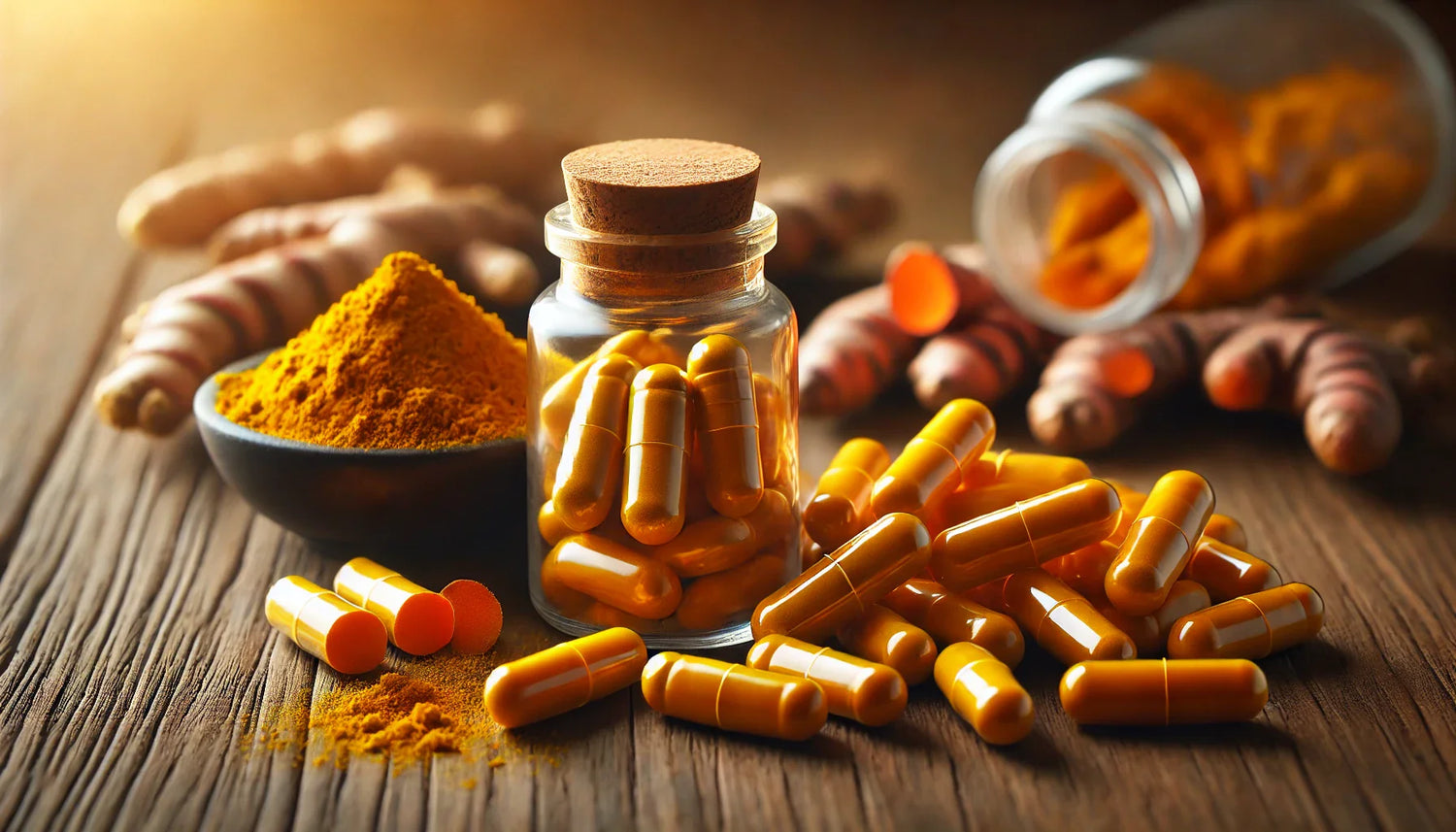Turmeric is on everyone's lips, we whisper that it is painkiller, we whisper that it calms inflammation and we shout that it is a magical spice.
What is it really ? Are all turmerics equal? Can everyone use it?
Discover in this complete article curcumin, the active molecule of turmeric, how to properly assimilate it and in which cases to use it.
01. What is turmeric?

History of turmeric
Turmeric is a plant from the Zingirebaceae family (like ginger) that grows in Southeast Asia. From its rhizome , that is to say its root, we extract orange powder, used as a spice since Antiquity in India in particular.
The roots are picked after 8 months of maturity of the plant then cleaned and dried before grinding to obtain this aromatic powder with characteristic orange highlights.

Indians love this “sacred” spice and use it in their curry in cooking and in their traditional Ayurvedic medicine.
On the spice route from East to West, turmeric traveled from India to Europe, via China where it is also very appreciated in traditional medicine.
In India, its cultivation is an important economic issue since it is the number one growing country of this spice and world exporter.
It must be said that turmeric is full of interesting and active molecules.
Active ingredients of turmeric
Turmeric root contains well-studied chemicals, the best known of which is curcumin.

CURCUMIN
It is the most abundant molecule in the turmeric rhizome.
Curcumin is the natural pigment in turmeric which gives it its orange color. It is a polyphenol which has powerful anti-oxidant properties.

OTHER MOLECULES
Turmeric is full of other anti-oxidants like desmethoxycurcumin, bidesmethoxycyrcumin and dihydrocurcumin.
It also contains vitamins, notably C and E, and trace elements which will participate in the assimilation of curcumin.
This aromatic complex contained in turmeric gives it numerous health benefits:
02. Benefits of turmeric
Turmeric has been widely used for thousands of years in traditional Indian and Chinese medicines. It has many health benefits:

Benefits of turmeric on digestion
Turmeric has cholagogue properties , meaning it stimulates the production of bile salts in the gallbladder.
These bile salts are used to “emulsify” dietary fats to better eliminate them via the liver.
Turmeric will therefore help digestion, particularly fats, and will relieve the liver.
Due to its anti-oxidant action , it will also protect the digestive mucosa and reduce its inflammation.
It is effective on bloating linked to a meal too high in fat.

Benefits of turmeric on pain
It can then be very useful in certain inflammatory and pain contexts:
- Osteoarthritis
- Muscle aches
- Lumbago
- Torticollis
- Tendonitis
- Sprains
- Significant skin inflammations: eczema attack, psoriasis
By acting on the pro-inflammatory cascade, turmeric molecules modulate the level of inflammation in an effective and measurable way by
inhibiting the synthesis of interleukins, chemical messengers of inflammation.
Unlike synthetic non-steroidal anti-inflammatory drugs, the molecules have no deleterious action on the stomach and are better tolerated.

Contraindications to the use of turmeric
As it stimulates the bile ducts, it should not be used in people suffering from biliary or liver diseases: gallstones, liver failure.
As curcumin has slightly hypoglycemic properties, it should be avoided in treated diabetics .
It will also not be used in people being treated with anticoagulant medication .
Due to its anti-inflammatory nature, it should be avoided in pregnant and breastfeeding women.
We will also be cautious in people treated with chemotherapy . If in doubt, seek advice from your pharmacist or doctor.
Turmeric has many health benefits, however, not everything is so simple with turmeric and it has limitations in terms of its bioavailability and duration of action.
03. How to benefit from the benefits of turmeric?
The assimilation of turmeric is capricious and depends on many factors:

Quality of turmeric
CULTURE, HARVEST AND PRODUCTION
Of course, the quality of cultivation, harvesting, cleaning, drying and preparation of turmeric powder will influence its active ingredient content.
There are strict production protocols to follow.
Not all turmeric producers are equal as in all medicinal plant crops.
Some unscrupulous people will add more or less inert powders: talc, flours to cut the turmeric powder and reduce production costs.

CURCUMIN TITRATION
The curcumin titration , i.e. the precise quantity extracted from the molecule, must be indicated on quality turmeric as a food supplement. Without this titration, it is impossible to guarantee the effectiveness of the plant in capsule form.
It is recommended not to exceed the daily dose of 180 mg of curcumin titrated for an adult.
Bioavailability of turmeric
To reveal its properties and health benefits, turmeric must be assimilated correctly by our bodies to enter the cells and play its role there. However, this is where the problem lies, turmeric is difficult to
assimilable .
There are several processes to boost its bioavailability:

ADDING CO-FACTORS
The addition of assimilation co-factors will potentiate the assimilation of active ingredients: we often see piperine, a molecule from black pepper to help turmeric molecules penetrate into cells.

PATENTED LIPID MEMBRANE PROCESS
Liposome technology, or lipid membrane, will “coat” the active molecules of turmeric and enormously facilitate their passage to the heart of our cells.
Indeed, our cells also have a lipid membrane and will more readily allow molecules of the same nature to pass through.
The bioavailability of turmeric is increased more than a hundredfold and its duration of action is extended.
Now that we know what turmeric is, let's see in detail how to incorporate it into our lives in cases of pain or digestion problems for example:
03. Concrete uses of the benefits of turmeric
Turmeric is a popular spice and can be consumed in everyday food or as a dietary supplement:

Turmeric in food
It can be found in dry orange powder in the spice section, or in fresh roots to grate in the fruit and vegetable section (often next to ginger).
The fresh root will be more interesting because the rhizome retains all the properties of turmeric in the raw and unprocessed food. This ensures the antioxidant content.
Be careful not to stain yourself, as it is a tough pigment. Here are some general ideas for using turmeric in cooking:
- Pumpkin soups flavored with turmeric
- Golden milk: milk drink flavored with spices
- Aromatic ginger and turmeric herbal tea
- Carrot-orange smoothie
- Vegetable or meat curries
- Turmeric flavored rice
Please note, however, that with this culinary use of turmeric, the doses ingested are not therapeutic because they are insufficient. They nevertheless contribute to good digestive health and reduce overall inflammation.

As a dietary supplement
Turmeric titrated capsules are available as food supplements in pharmacies and organic stores in the form of powders, liquids and capsules.
Be sure to check the titration and bioavailability of curcumin.
Good, pure, quality and easily assimilated turmeric costs more than a simple powder mixed with other substances. There is always something behind a price. Cheap turmeric will not have the same health benefits because its quantity of active ingredients will be less and its assimilation will be more laborious.
Taking turmeric as a food supplement is useful in cases of inflammatory pain or slowed digestion. However, the choice of turmeric is essential to guarantee these health effects.
It's not a magic spice. It must be of quality and worked to become very assimilable and therefore therapeutic.
Obtain advice from a healthcare professional before using it.
We remind you that turmeric as a food supplement is not recommended for pregnant and breastfeeding women, as well as people suffering from biliary or liver diseases.
In case of pain or inflammation, it is also interesting to turn to anti-inflammatory foods.



